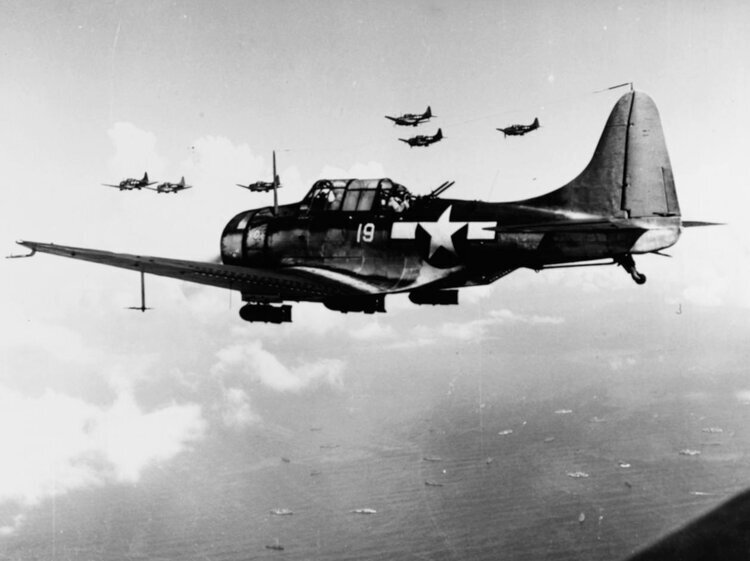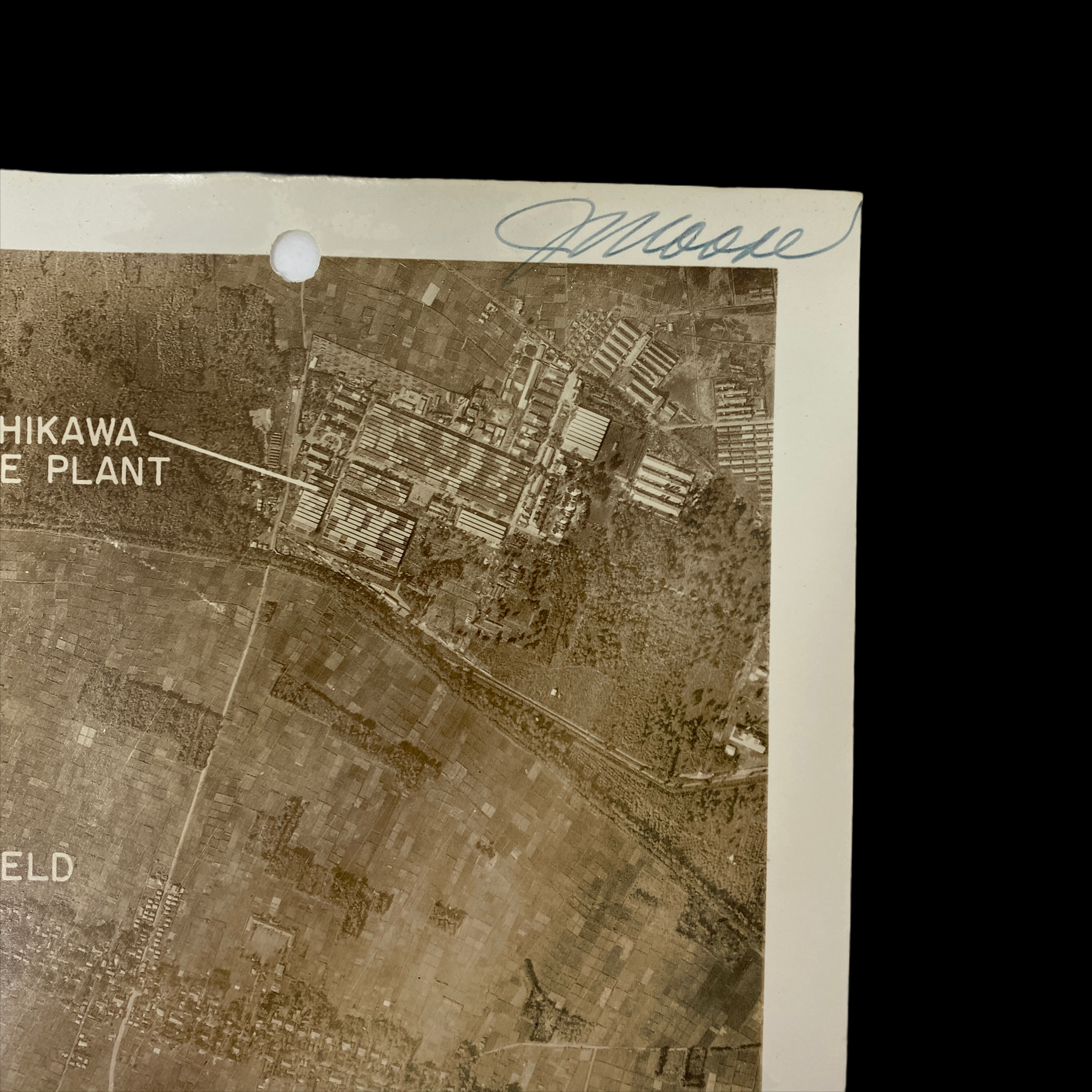Lt. Moore "CONFIDENTIAL" USS Enterprise's Night Air Group 90 (NAG-90) "Tokyo Raids" (Tachikawa) - TARGET Aerial Reconnaissance Photograph











Lt. Moore "CONFIDENTIAL" USS Enterprise's Night Air Group 90 (NAG-90) "Tokyo Raids" (Tachikawa) - TARGET Aerial Reconnaissance Photograph
Size: 8 x 8 inches
Letter of Authenticity included.
“We now know we are on our way to write history with the first carrier plane strike on Tokyo!"
VT(N)-90 Squadron History, Feb. 16, 1945
The USS Enterprise is accredited with combat participation in the Fifth Fleet Tokyo Raids from February 16-17th, 1945. Aimed at drawing Japan's attention away from the impending Iwo Jima landings, and hinder Japan's ability to throw air attacks against the landing forces, the strikes on Tokyo involved nearly 800 Navy fighters, bombers, and torpedo planes: blasting airfields, shipping and port facilities and industrial targets in and around Tokyo. Enterprise's Night Air Group 90 (NAG-90) flew into Tokyo Bay at dusk February 16, attacking the air base at Yokosuka, tearing up planes and airfields, radio and radar installations, trains and depots. Quote from Captain Hall as noted in the USS Enterprise ‘AFTER ACTION REPORT’….“To the Officers and the Crew of the ENTERPRISE and her Air Group. Words cannot express the feeling of pride in the performance of the entire crew in yesterday's attack. All hands performed splendidly and bravely. I hope to make the above rewards part of every officer's and man's record.” Over 800 American carrier planes participated in the strikes, destroying over 500 enemy planes, sinking a number of ships and boats, including the 10,600 ton Yamashiro Maru, and damaging a number of factories and other installations. Losses were unexpectedly high, due largely to the high percentage of inexperienced American airmen: sixty planes were lost in combat, and another 28 forced to ditch or otherwise lost.
*This TARGET marked aerial reconnaissance photograph was directly used and carried by Lt. Moore flying with the Night Air Group 90 of the USS Enterprise Air Group during the Tokyo Raids. This CONFIDENTIAL target photo contains Moore’s name and signature located in the upper right.
This extremely rare ‘CONFIDENTIAL’ World War II Joint Intelligence Center Pacific Ocean Area (JICPOA) high altitude aerial reconnaissance photograph was taken a specially outfitted B-29 Superfortress aircraft of Bomber Command operating out of the Pacific Theater where it was then developed after a special flight reconnaissance mission over Tokyo, Japan. Following the bomber groups return and landing on an occupied Allied island airfield, this photograph was developed by reconnaissance where it was then examined, marked and sent to PHASE 1 (Tactical Interpretation) and PHASE 2 (Strategic Interpretation) of the photo intelligence unit. Reconnaissance units would take the aerial photographs, print them, and identify them. PHASE 1 (Tactical Interpretation) then examines the aerial reconnaissance photos for immediate military operations and PHASE 2 (Strategic Interpretation) examines the reconnaissance photos for future military operations.
This “TARGET” marked aerial reconnaissance photo was carried and used by Lt. Moore of the USS Enterprise Air Group. He along with other USS Enterprise carrier pilots, officers, and high ranking commanders were given these photo intelligence marked aerial recon photographs in order to identify targets of Tokyo, Japan.
This target aerial recon photograph was used in pre mission briefings to familiarize USS Enterprise pilots on their objectives and target assignments before taking off the deck of the carrier. This aerial photograph also allowed Lt.Moore and other pilots the ability to get a “first hand look” of what their targets looked like on their approach making it easier to spot and call out targets designations from the air and allow USS Enterprise Air Group pilots the ability to accurately and efficiently locate and destroy designated targets.
USS Enterprise and the Fifth Fleet Tokyo Raids:
By February 15, it was decidedly chilly above decks, and the men working the flight deck and manning the guns and lookouts bundled up against the cold wind, breaking out heavy clothing that had sat practically unused until now, and wondering where the fleet was heading.
The answer came a few hours later. At 1900 hours, TF 58 abruptly changed course to the northwest and leapt forward, and its mission was announced. Over the next two days, TF 58 would launch the first carrier plane attacks against Tokyo and the Japanese home islands.
If Enterprise had a soul - and many who sailed with her believe she did - the touch of the cold north Pacific waters against her hull must have brought back memories. A little more than a thousand days before - April 18, 1942 - Enterprise and her now-sunken sister ship Hornet CV-8, had carried Jimmy Doolittle's 16 B-25 bombers within 650 miles of Tokyo, and launched the first American bombing raid against Japan of the war. No carrier had closed so close before or since. Now, the Big E found herself not with one other carrier, but with fifteen, steaming to a position just 60 miles off the main Japanese home island of Honshu, not to launch one strike and turn tail, but to stay and attack for two full days.
Unlike the Doolittle Raid, which was intended to be a morale booster for the home front and partial retribution for Pearl Harbor, the February 1945 Tokyo raids had a more concrete purpose. On February 19, just three days away, Marines of the 3rd, 4th and 5th Divisions would be assaulting Iwo Jima. TF 58's mission was to draw Japan's attention away from the impending landings, and hinder Japan's ability to throw air attacks against the landing forces. Though Major General Curtis LeMay's Marianas-based B-29s had been regularly bombing the Home Islands since late November, they'd had little effect on Japan's ground-based air forces. These would be the primary target for Spruance and Mitscher's airmen.
The night before the first strikes, few if any men in the Task Force got any sleep. Excitement over approaching so close to the enemy's home mixed with apprehension due to knowledge that for more than half of TF 58's air groups, this was their first mission. Mitscher was sensitive to this, telling the airmen, "He [the enemy] is probably more afraid of you than you are of him", but warning them to use teamwork and maintain discipline.
As a night carrier, Enterprise's primary role during the daylight hours was to provide Combat Air Patrol for the Task Force. Night Air Group 90, however, was then at the cutting edge of electronic warfare, and launched several secret missions, as well as dusk and night strikes.
At 0400 February 16, two hours before the other carriers launched their first strikes, Enterprise launched an "RCM" mission. RCM stood for Radar Counter-Measure, and the single, specially-modified TBM Avenger's mission was to confuse Japanese radar installations, disrupting the enemy's ability to intercept the morning strikes and guess TF 58's intentions.
At dawn, TF 58, just 60 miles off the coast of Honshu, and 120 miles southeast of Tokyo, launched its first fighter sweeps into heavily overcast skies. Concentrating on the airfields around Tokyo, these strikes met little opposition, except for the planes from TG 58.2 (carriers Lexington CV-16 and Hancock CV-19), which encountered approximately 100 Japanese interceptors. As would be the case throughout the raids, the enemy seemed reluctant to tangle too closely with the American fighters. The Hellcats knocked down forty of the enemy planes. Despite Mitscher's urging to focus on teamwork, some inexperienced pilots broke away to pursue the Japanese, leading to greater American losses than were probably necessary.
Worried by the continuing poor weather, Mitscher ordered strikes against airframe and engine plants earlier than scheduled, inflicting heavy damage on two plants northwest of Tokyo. The Big E got back into the action late in the afternoon, launching twelve VF(N)-90 Hellcats at 1615 on a "zipper" mission against the enemy airfields at Yokosuka. One plane, flown by ENS Frank Luscombe, crashed shortly after takeoff. Luscombe succumbed to his injuries and the cold before a destroyer could pluck him from the water. The remaining eleven planes flew on, intent on "zipping up" the Japanese airfields, preventing attacks against planes returning from the daytime strikes, and the 116 ships of TF 58.
Skimming over the Chiba Peninsula, the fighters first flew over the air base at Tateyama. Finding no activity there, they continued southwest over Cape Nojima, before turning to the north-northeast and racing straight up Tokyo Bay. Eight minutes later, with the sun low on the horizon, the Hellcats closed on the major air and naval base at Yokosuka, just south of Tokyo itself. Here they encountered heavy anti-aircraft fire, which they endured while attacking the base. While three Hellcats provided air cover (fending off two hesitant enemy planes), the other eight separated into two divisions and dove on the air base.
The first division, led by LT Russell Otis, separated into two sections during the dive, strafing fighters and bombers parked on the north and south ends of the airfield, and destroying a number of planes. The effect was a bit disappointing, however: the Japanese had apparently emptied the planes of fuel and munitions, depriving the VF(N)-90 pilots the satisfaction of inflicting damage beyond that done by their .50-caliber guns.
The second division, led by LT Kenneth Smith and LT Owen Young, strafed and rocketed the airfield, before sweeping out over Tokyo Bay and strafing four freighters, leaving one dead in the water and smoking. Returning eastward over the Chiba Peninsula, the fighters inspected airstrips at Naruto, Katori and Choshi, finding no signs of activity. After strafing a few parked planes at Choshi, the marauding Hellcats turned their guns towards other targets, attacking a radio tower, a radar site, a factory, and three trains.
An hour and fifteen minutes after launching VF(N)-90's zipper mission, the Big E launched a second, secret electronic warfare mission. A TBM Avenger, piloted by LT Charles Henderson and accompanied by a VF(N)-90 Hellcat, stationed itself over the southern end of Tokyo Bay, to monitor and jam Japanese radar. Aside from sheltering TF 58 from radar detection, the mission also succeeded in identifying twenty three separate enemy radar installations, information that would prove of value as Allied units increasingly operated in Japanese waters.
With the exception of ENS Luscombe, all airmen returned safely, though VF(N)-90 pilot ENS Fred Hunziker was forced to ditch near the fleet, and another Hellcat crashed into the barriers while landing on Enterprise.
Enterprise was not done for the night. At 0130 February 17, she launched eleven radar-equipped Avengers, to search for and attack enemy surface units and shipping. Consistent with the defensive role Enterprise filled during this engagement, the Avengers were to ensure that enemy surface units known to be stationed in the Inland Sea did not slip out under cover of darkness, to surprise Mitscher's thin-skinned carriers in the morning. This threat never materialized, however, and the Avenger crews had to be content with attacking airfields on Hachijo Jima and Nii Shima, south of Tokyo Bay. A final, diversionary strike was launched at 0300, which proceeded well south along the Honshu coast, heckling targets and generating misleading radio traffic, again to deceive the Japanese regarding TF 58's intentions.
Before dawn, the Big E recovered her strikes - losing an Avenger and three airmen to an apparent case of vertigo - and resumed flying CAP and anti-submarine patrols. Mitscher's carriers launched fighter sweeps at dawn on the 17th, and attacked three factories near Tokyo, before withdrawing shortly before noon. The thick weather which had protected the fleet during its approach had also hampered its air operations, forcing Mitscher's early withdrawal.